This is a list of the decrees of the First Plenary Council in Baltimore of the American Catholic Church. Meeting in 1852 in Baltimore, Maryland, the council was the first national gathering of all American bishops, archbishops, and leaders of major religious orders. [1] The conference published the decrees listed in this article to serve as policies and procedures for Catholic leaders and laypeople in the United States. [2] [3]
| Decrees of the First Plenary Council |
|---|
| Decrees for all Catholics |
| These decrees are binding as soon as they are published by the Archbishop of Baltimore after their revision and approval by the Holy See. |
| The Fathers profess their allegiance to the pope as the divinely constituted head of the Church, whose office it is to confirm his brethren in the Faith. They also declare their belief in the entire Catholic Faith as explained by the ecumenical councils and the constitutions of the Roman pontiffs. |
| The enactments of the seven provincial councils of Baltimore are obligatory for all the dioceses of the United States. |
| The Roman Ritual, adopted by the First Council of Baltimore, is to be observed in all dioceses, and all are forbidden to introduce customs or rites foreign to the Roman usage. Sacred ceremonies are not to be employed in the burial of Catholics whose bodies are deposited in sectarian cemeteries; or even in public cemeteries, if there be Catholic cemeteries at hand. |
| The Baltimore "Ceremonial" is to be used all through the country. |
| Decrees for bishops and archbishops |
| Bishops are to observe the canons concerning ecclesiastical residence. |
| Bishops are exhorted to choose consultors from among their clergy and to ask their advice in the government of the diocese. A monthly meeting of these consultors to discuss diocesan affairs is praiseworthy. |
| A chancellor should be constituted in every diocese, for the easier and more orderly transaction of business. |
| Bishops should appoint censors for books relating to religion. |
| Bishops are exhorted to have a Catholic school in every parish and the teachers should be paid from the parochial funds. |
| The bishops or their delegates should demand every year an account of the administration of church funds from those who administer them, whether laymen or clerics. |
| The bishops or their delegates should demand every year an account of the administration of church funds from those who administer them, whether laymen or clerics. |
| Bishops should use their influence with the civil authorities to prevent anyone in the army or navy from being obliged to attend a religious service repugnant to his conscience. |
| A petition should be addressed to the Holy See asking for extraordinary faculties concerning matrimonial cases and the power, also, of delegating such faculties. |
| Our quasi-parishes should have well-defined limits, and the jurisdiction and privileges of pastors should be indicated by the bishops. The ordinary can change these limits and it is his right to appoint the incumbents. |
| A Society for the Propagation of the Faith, similar to that in France, should be fostered and extended. |
| Decrees for priests |
| European priests desiring to be received into an American diocese must have written testimonials from their former bishops and the consent of the ordinary here. |
| After next Easter, matrimonial banns must be published, and bishops should dispense with this only for grave reasons. |
| Pastors themselves should teach Christian doctrine to the young and ignorant. |
| When the title to a church is in the bishop's name, pastors are warned not to appoint trustees or permit them to be elected without the bishop's authority. |
| Benediction of the Blessed Sacrament must be performed in all dioceses in the manner prescribed by the Baltimore "Ceremonial". |
| Decrees for lay people |
| Laymen are not to take any part in the administration of church affairs without the free consent of the bishop. If they usurp any such authority and divert church goods to their own use or in any way frustrate the will of the donors; or if they, even under cover of the civil law, endeavour to wrest from the bishop's hands what has been confided to his care, then such laymen by that very fact fall under the censures constituted by the Council of Trent against usurpers of ecclesiastical goods. |
| The faithful are exhorted to enter into a society of prayer for the conversion of non-Catholics. |
| The sixth decree of the Seventh Provincial Council of Baltimore is to be understood as applying to those who rashly (temere) marry before a Protestant minister. Priests should give no benediction to those whom they know to intend to remarry before a preacher, or who, having done so, show no signs of penitence. |

The Metropolitan Archdiocese of Baltimore is the archdiocese of the Latin Church of the Catholic Church in northern and western Maryland in the United States. It is the metropolitan see of the Ecclesiastical Province of Baltimore.

Francis Patrick Kenrick was an Irish-born prelate of the Roman Catholic Church who served as the third bishop of the Diocese of Philadelphia in Pennsylvania (1842–1851) and the sixth archbishop of the Archdiocese of Baltimore in Maryland(1851–1863).

The Society for the Propagation of the Faith is an international association coordinating assistance for Catholic missionary priests, brothers, and nuns in mission areas. The society was founded in Lyon, France, in 1822, by Pauline Jaricot. It is the oldest of four Pontifical Mission Societies of the Catholic Church.
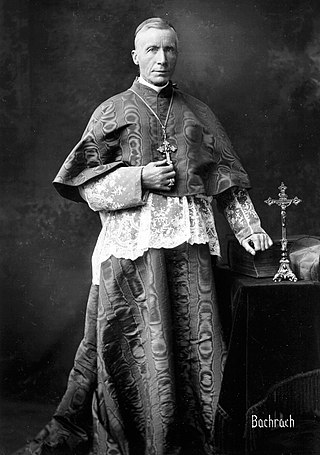
James Cardinal Gibbons was a senior-ranking American prelate of the Catholic Church who served as apostolic vicar of the Apostolic Vicariate of North Carolina from 1868 to 1872, bishop of the Diocese of Richmond in Virginia from 1872 to 1877, and as ninth archbishop of the Archdiocese of Baltimore in Maryland from 1877 until his death. He was elevated to the rank of cardinal in 1886.
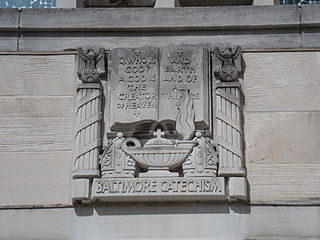
A Catechism of Christian Doctrine, Prepared and Enjoined by Order of the Third Council of Baltimore, or simply the Baltimore Catechism, was the national Catholic catechism for children in the United States, based on Robert Bellarmine's 1614 Small Catechism. The first such catechism written for Catholics in North America, it was the standard Catholic school text in the country from 1885 to the late 1960s. From its publication, however, there were calls to revise it, and many other catechisms were used during this period. It was officially replaced by the United States Catholic Catechism for Adults in 2004, based on the revised universal Catechism of the Catholic Church.

The Archdiocese of Washington is a Latin Church ecclesiastical territory, or archdiocese, of the Catholic Church for the District of Columbia and several Maryland counties in the United States.

The Diocese of Wilmington is a Latin Church ecclesiastical territory – or diocese, of the Catholic Church in the eastern United States. The diocese comprises the entire state of Delaware and the Eastern Shore Region of Maryland.
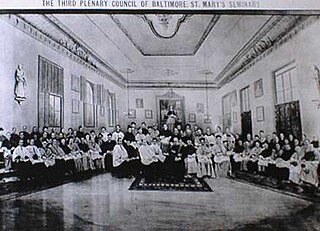
The Plenary Councils of Baltimore were three meetings of American Catholic bishops, archbishops and superiors of religious orders in the United States. The councils were held in 1852, 1866 and 1884 in Baltimore, Maryland.
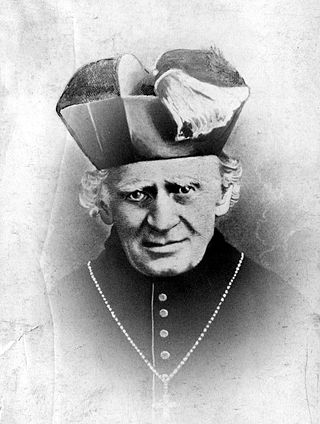
Peter Richard Kenrick was an Irish Catholic priest who served as Bishop of St. Louis from 1843 to 1895. The see was made an archdiocese in 1847, when he was called as the first archbishop west of the Mississippi River. The archdiocese covered nearly all the territory of the Louisiana Purchase. He served in this position for nearly 50 years, until months before his death.
The Provincial Councils of Baltimore were councils of Roman Catholic bishops that set the pattern for Catholic organisation in the United States. They took place in Baltimore. They were seen as having a unique importance for the Church in the United States, inasmuch as the earlier ones legislated for practically the whole territory of the Republic, and furnished moreover a norm for all the later Plenary Councils of Baltimore covering the whole country. This article touches upon only those parts of the canonical legislation which may seem in any way to individualize the discipline of the Church in the United States or depict the peculiar needs and difficulties of its nascent period.

James Whitfield was an English-born prelate of the Roman Catholic Church in the United States. He served as archbishop of the Archdiocese of Baltimore in Maryland from 1828 until his death in 1834.

Samuel Eccleston, P.S.S. was an American prelate of the Roman Catholic Church who served as the fifth Archbishop of the Archdiocese of Baltimore, Maryland from 1834 until his death in 1851.
In the Roman Catholic Church, a plenary council is any of various kinds of ecclesiastical synods, used when those summoned represent the whole number of bishops of some given territory. The word itself, derived from the Latin plenarium, hence concilium plenarium, also concilium plenum. Plenary councils have a legislative function that does not apply to other national synods.

William George McCloskey was an American Catholic priest, who became the fourth Bishop of Louisville, Kentucky.
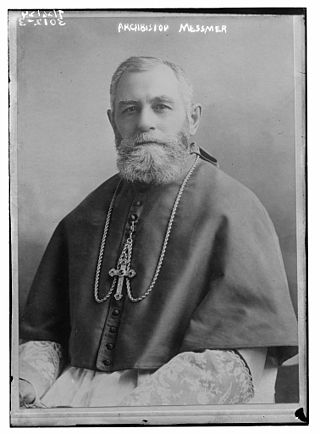
Sebastian Gebhard Messmer was a Swiss-born prelate of the Roman Catholic Church. He served as bishop of the Diocese of Green Bay (1892–1903) and Archbishop of the Archdiocese of Milwaukee (1903–1930).

Catholic schools in the United States constitute the largest number of non-public, Christian schools in the country. They are accredited by independent and/or state agencies, and teachers are generally certified. Catholic schools are supported primarily through tuition payments and fundraising, and typically enroll students irrespective of their religious background.
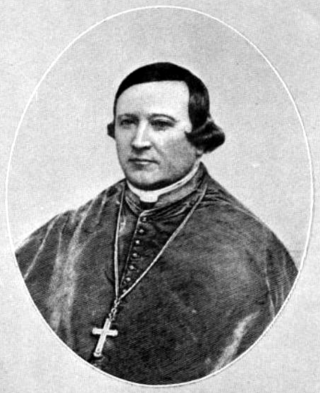
Bernard O'Reilly was an Irish-born prelate of the Roman Catholic Church. Known for his service during the 1832 cholera outbreak in New York, he later served as Bishop of Hartford from 1850 until his death in 1856.

John Carroll was an American prelate of the Catholic Church who served as the first bishop of the Diocese of Baltimore, the first diocese in the new United States. He later became the first archbishop of Baltimore. Until 1808, Carroll administered the entire American Catholic Church.
In 1800 the Catholics were a small minority everywhere except Maryland. Immigration from Ireland and Germany gave them millions of adherents from the 1840s to the 1880s. Then came millions more from Italy, Poland and Eastern Europe, as well as French Canada. Large numbers of priests and nuns came from Ireland and France. The Irish soon dominated the clergy church, with a great majority of bishops by 1900. As the immigrants arrived new parishes and diocese were created. Rebuffed in efforts to obtain government funds for schools, the Catholics set up a parochial school system largely staffed with nuns. It reached about a third of the children. They also set up colleges. There were few Catholics in the South, apart from Louisiana. However they were well represented in the nation's cities, mill towns and mining centers. Anti-Catholic politics flared briefly in the 1850s, but the Catholic voters surged into the Democratic Party and Irish Catholic politicians played increasingly dominant roles in Democratic machines in Boston, New York, and other major cities. Devotional practices included daily rosary prayers, regular attendance at Sunday Mass, and special roles for devotion to the Blessed Virgin Mary and favorite saints.
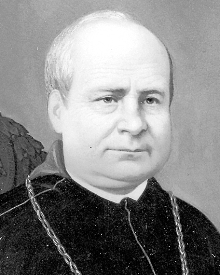
Peter Paul Lefevere, or Lefebre, was a 19th-century Belgian born bishop of the Catholic Church in the United States. He was a missionary priest in the states of Missouri, Illinois and Iowa before he served as coadjutor bishop of the Diocese of Detroit in the state of Michigan from 1841-1869.
![]() This article incorporates text from a publication now in the public domain : Herbermann, Charles, ed. (1913). "Plenary Councils of Baltimore". Catholic Encyclopedia . New York: Robert Appleton Company.
This article incorporates text from a publication now in the public domain : Herbermann, Charles, ed. (1913). "Plenary Councils of Baltimore". Catholic Encyclopedia . New York: Robert Appleton Company.